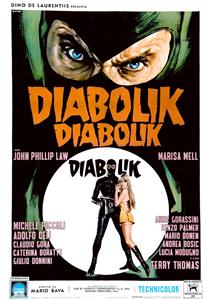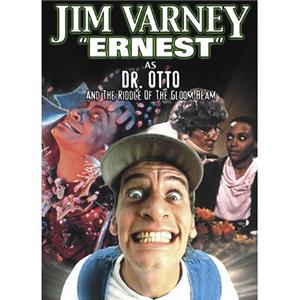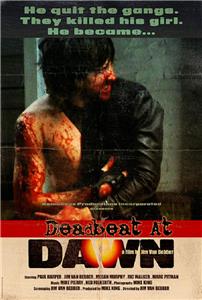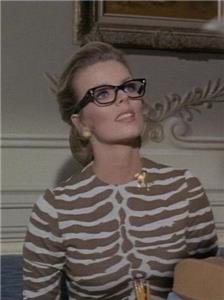Diabolik (1968) Online

In psychedelic swinging 60s style, the dreaded thief (and killer) Diabolik wreaks havoc on a generic European country for his own financial gain and amusement. He shares an extravagant underground lair (and a giant bed of money) with his curvaceous, superficial girlfriend...who uses her awesome powers of wig-wearing to help Diabolik kill innocent people and steal billions from the government. Nonetheless, Diabolik is the "hero" of the film because he must face off against bumbling cops and revenge-seeking mafiosos.
| Cast overview, first billed only: | |||
| John Phillip Law | - | Diabolik | |
| Marisa Mell | - | Eva Kant | |
| Michel Piccoli | - | Inspector Ginko | |
| Adolfo Celi | - | Ralph Valmont | |
| Claudio Gora | - | Police Chief | |
| Mario Donen | - | Sergeant Danek | |
| Renzo Palmer | - | Mr. Hammond - Second Minister of the Interior | |
| Caterina Boratto | - | Lady Clark | |
| Lucia Modugno | - | Prostitute | |
| Annie Gorassini | - | Rose | |
| Carlo Croccolo | - | Lorry Driver | |
| Lidia Biondi | - | Policewoman (as Lidia Biondi C.S.C.) | |
| Andrea Bosic | - | Bank Manager | |
| Federico Boido | - | Joe - Valmont's Henchman | |
| Tiberio Mitri | - | Valmont's Henchman |
The movie is based on "Diabolik", one of the longest running - and most successful - Italian comic strips (known as "fumetti"). It was created by Angela Giussani and Luciana Giussani, two Milan sisters who built a small but very profitable publishing empire out of the "King of Terror"'s success. In the comic version, "Diabolik" is much more sinister than its cinematic counterpart - he's a criminal fighting evil with evil, often resorting to murder to "punish" the evildoers he meets. The film was made assuming some knowledge of the fumetti, thus explaining the negative reaction it initially received outside Italy, although it has since been reevaluated as a classic of 1960s cinematic psychedelia and pop art.
This film was produced by Dino De Laurentiis (later responsible for the infamously mammoth King Kong (1976) and Hurricane (1979)), and its 3-million budget was much more than director Mario Bava was used to and enabled him to work with more money and a much more prestigious cast than he normally did. However, he remained true to his principles, relying on imagination rather than money, and brought in the film substantially under budget, at a mere $400,000. De Laurentiis was so impressed with Bava's saving him so much money that he offered Bava the opportunity to make a sequel with the leftover funds, but Bava had by then tired of working with the producer and decided to pass.
The American trailers feature a brief shot of the exterior of Eva's white Jaguar, in which Eva can be seen wearing a white long-sleeved dress that bears no resemblance to the sleeveless red dress in the scene featured in the film. This is the only remnant of footage featuring Catherine Deneuve as Eva known to exist.
According to John Phillip Law, the first choice for the role of Eva Kant was an unknown model from New York, who was a friend of Charlie Bluhdorn, the CEO of Gulf & Western, the conglomerate that owned Paramount Pictures (which had been contracted to distribute the film in the US); she was fired from the film shortly before shooting began. At the suggestion of Barbarella (1968) director Roger Vadim, Catherine Deneuve was cast and lasted for about a week, until Law, Mario Bava and Dino De Laurentiis decided that she was miscast. Bava was asked to recast Eva; after considering both Marilù Tolo and Marisa Mell, he eventually settled on Mell, although he would later cast Tolo as the female lead in 3 Halunken und ein Halleluja (1970).
The film originally began production with Seth Holt as director, but Dino De Laurentiis wasn't happy with Holt's take on the film, describing the initial footage that he shot to be "of a level so low, both from an artistic and commercial point of view, as to make us clearly understand that to continue on that path meant heading toward disaster". According to David Sherwin's autobiography, Holt's mantra was "Never quit, always make them fire you!", and so De Laurentiis was forced to pay him off and let him go.
When Valmont is trying to determine Eva Kant's appearance, the "identikit" sequence generates images of Barbarella (portrayed by Jane Fonda in Barbarella (1968), the sister production of this film) and British model Twiggy. The resulting image of Eva was drawn by Angela Giussani and Luciana Giussani, with their usual design of the character being modified to resemble Marisa Mell.
Featured in the final episode of Mystery Science Theater 3000 (1988). (August 8, 1999).
In Seth Holt's initial version of the film, Diabolik and Eva Kant were played by Jean Sorel and Elsa Martinelli, respectively. Both would later be paired with Mario Bava's Eva, Marisa Mell, in Lucio Fulci's Nackt über Leichen (1969).
John Phillip Law was asked to audition for Diabolik by Dino De Laurentiis as a favor because the filming of Barbarella (1968), for which Law had already been cast in as Pygar, had been postponed. An avid comic book fan since childhood, Law studied Angela Giussani and Luciana Giussani's original "fumetti" for inspiration, as he had done for Barbarella. Upon realizing that the most distinctive aspect of Diabolik's physical appearance was his eyebrows, he applied mascara to his own and trained himself to convey a wide array of expressions with them. Upon meeting with De Laurentiis and Mario Bava, the director exclaimed "Ah, questo Diabolik!" ("This is Diabolik!"), indicating to Law that he had won the part.
Among the crew members were future Oscar winners Carlo Rambaldi (who accepted an offer from Dino De Laurentiis to work on the special effects of King Kong (1976) that Mario Bava had turned down) and Ennio Morricone.








User reviews